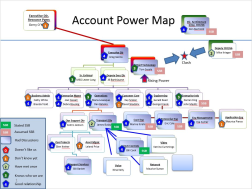When is the last time you looked at a map? A real, paper, takes-up-the-whole-front-seat-of-the-car type of map? It’s probably been a while. Who needs a map when GPS is a function of nearly every device in your repertoire? But before you shrug off the need for a map, think, for a moment, about the true purpose of a map. Generically speaking, it’s a method for finding a path from Point A to Point B, and being able to visually see obstacles along the way.
What Is a Power Map?
Although used for a much different purpose, a Power Map is similar in functionality. It provides you with a visual representation of an organization you are trying to infiltrate – what is the best way to get from Point A (virtually unknown) to Point B (well known throughout the Agency). As any experienced Capture Executive knows, there is a technique to applying a Power Map successfully. The path is planned, calculated, and adjusted along the way as new information comes to light. This sounds far more covert than intended.
A Power Map is a concept of where your company’s connections and areas of support lie within a specific organization, and where you have gaps in connections or contacts that need work.
The Agency’s Organizational Chart
Start with the Agency’s organizational (org) chart. These can typically be found on the Agency’s website, and are, for the most part, up to date. It works best to transpose the org chart to a software product that everyone in the organization can see and utilize. Identify any persons (knowns) on the org chart with whom you, or someone in your organization, has a working relationship. Mark them and grade them as to how well you know them and they know you.
Next, identify those individuals in power positions, and cross-reference them with the ‘knowns.’ Those ‘knowns’ then become your initial targets for your target call list. The remaining power positions are to follow.
Acting on Your Findings
You shouldn’t construe the term ‘meeting’ as a one-time affair. There are hundreds of businesses vying for time and position with the same customer; you have to make your presence known. As you continue to meet with these individuals, develop a ranking system of how well that individual knows you and your organization. This is a fluid number, and can change for any given person based on your interaction with them.
As your working relationship with them grows, begin to identify who you perceive to be potential candidates for their Source Selection Board (SSB) for that one particular opportunity you’re pursuing. Ask many different people in the organization to find this answer and it will likely change as you continue to ask around. You can indicate individuals as those you think might be on the SSB, and those you have more confirming information that you feel may be on the SSB. This information will help drive your meeting pursuit.
Why Should You Use the Power Map?
The Power Map isn’t just for you as a Capture Executive. It’s for everyone in the company to utilize and update. Bill in the cubicle next to yours may play golf on Saturday’s with someone in a power position, or perhaps he worked with him at a previous company. Your boss may have a very good relationship with the 1-Star Deputy Director of that organization. Visually depicting the Agency, the relationships, and the impact of specific individuals, as it pertains to your business pursuit, can help you strategize on where best to expend your capture resources. There are only so many hours in the day, and so many people in your organization – plan your Capture Management strategy wisely.


